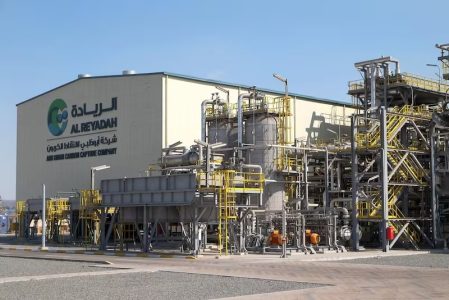The Gulf could be a “sweet spot” for climate-friendly products made with technology that captures carbon dioxide emissions from the air, the Abu Dhabi National Oil Company believes.
Hernan Silva, an Adnoc vice president responsible for carbon capture and storage, said the region had the potential to use its wells and reservoirs as a “storage hub” for carbon dioxide.
He told a London summit that Adnoc was “very confident indeed” of hitting a 2030 target to have 10 million tonnes of storage capacity.
Many countries see carbon capture as a key emissions-busting tool, even as critics say it is used to prolong the life of polluting plants and factories.
The main agreement at the Cop28 summit in the UAE called for the use of carbon capture to be “accelerated”, especially in sectors where it is hard to cut out carbon dioxide entirely.
Products made with the help of carbon capture and storage (CCS) are known as “blue” – for example, blue steel or blue ammonia.
“The GCC could become a sweet spot for low-carbon products, or blue products in particular,” Mr Silva told diplomats and investors at the Carbon Capture Global Summit in London.
“Access to abundant natural resources, natural gas, competitive prices, with massive CCS storage capacities onshore, makes the region very competitive.
“I am talking about the region, not only the UAE. Personally I’m very optimistic about the prospects for the region for low-carbon products.”

Adnoc opened its first carbon capture facility in 2016 at an Emirates Steel plant. Last year, it announced two new projects in which carbon dioxide will be injected underground into a network of wells and reservoirs.
Around the world, industries are looking at piping or shipping carbon dioxide across borders to be stored in other countries, including in the ocean.
Trapping carbon dioxide on the Earth in this way means it does not enter the atmosphere and contribute to global warming.
“Taking into account the potential in terms of storage capacities we may have in the region, these could transform the region into a potential storage hub for taking CO2 internationally,” Mr Silva said.
Bernhard Koudelka, head of Shell’s carbon capture business, said the Middle East and Asia would be the company’s next focus.
“We believe that after North America, Canada and Europe, these will be the next big projects that are coming up,” Mr Koudelka said.
Adnoc target
Adnoc’s Emirates Steel operation and the two projects being developed would take its storage capacity to 3.8 million tonnes of carbon dioxide per year.
It has a target of 10 million tonnes a year by 2030, by when it also hopes to cut the carbon intensity of its operations by a quarter.
The company is “very confident indeed in our capabilities to reach the 10 million tonnes by 2030″, Mr Silva said. Adnoc could offer carbon capture as a service to companies it operates but also to third parties such as the cement and waste sectors, he said.
Carbon capture is “essential for Adnoc to reach our climate targets” and for the UAE to reach net zero by 2050, he said.



